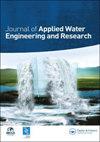Hydraulic model of a braided channel to aid design of a grade-building structure
IF 1.6
Q4 WATER RESOURCES
Journal of Applied Water Engineering and Research
Pub Date : 2022-08-04
DOI:10.1080/23249676.2022.2106520
引用次数: 0
Abstract
Presented here are considerations for designing a hydraulic model involving a broad reach of braided, sand-bed channel used to aid the design of a grade-building structure (GBS) for retaining bed sediment upstream of a sediment-deposition plain formed by a sediment-retention dam. The results focus on the similitude and calibration considerations needed to simulate bed-sediment transport along a large braided channel. Key variables in this regard were flow discharge, channel slope and sediment-transport rate. Additionally, the results describe how the GBS evolved in design from initially comprising four walls that lengthened flow path (thereby causing sediment deposition) to being four walls with openings that dispersed flow and consequently spread sediment deposition across the reach. The addition of rock aprons and wall bunds (curved, wall ends), enhanced sediment retention, reduced scour, and mitigated an under-wall seepage concern. In final design, the GBS retained approximately 83% of the bed sediment entering the reach over the test duration.辫状河道水工模型对分级建筑结构设计的帮助
这里提出了设计一个水力模型的考虑因素,该模型涉及一段广泛的辫状沙床河道,用于帮助设计一个阶梯式建筑结构(GBS),用于在由泥沙淤积坝形成的泥沙淤积平原上游保留河床沉积物。结果侧重于模拟沿大型辫状河道的河床泥沙输运所需的相似性和校准考虑。这方面的关键变量是流量、河道坡度和输沙速率。此外,研究结果还描述了GBS在设计上的演变,从最初的四面墙延长了流动路径(从而导致沉积物沉积),到四面墙有开口分散流动,从而使沉积物沉积在河段上。增加了岩石围护层和墙带(弯曲的、墙端),加强了沉积物的保留,减少了冲刷,并减轻了墙下的渗透问题。在最终设计中,GBS在测试期间保留了大约83%进入河段的河床沉积物。
本文章由计算机程序翻译,如有差异,请以英文原文为准。
求助全文
约1分钟内获得全文
求助全文
来源期刊

Journal of Applied Water Engineering and Research
WATER RESOURCES-
CiteScore
2.90
自引率
16.70%
发文量
31
期刊介绍:
JAWER’s paradigm-changing (online only) articles provide directly applicable solutions to water engineering problems within the whole hydrosphere (rivers, lakes groundwater, estuaries, coastal and marine waters) covering areas such as: integrated water resources management and catchment hydraulics hydraulic machinery and structures hydraulics applied to water supply, treatment and drainage systems (including outfalls) water quality, security and governance in an engineering context environmental monitoring maritime hydraulics ecohydraulics flood risk modelling and management water related hazards desalination and re-use.
 求助内容:
求助内容: 应助结果提醒方式:
应助结果提醒方式:


